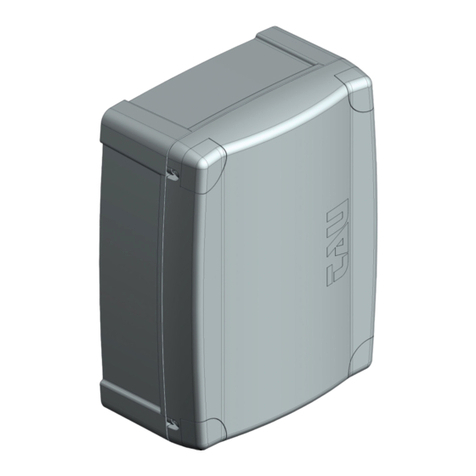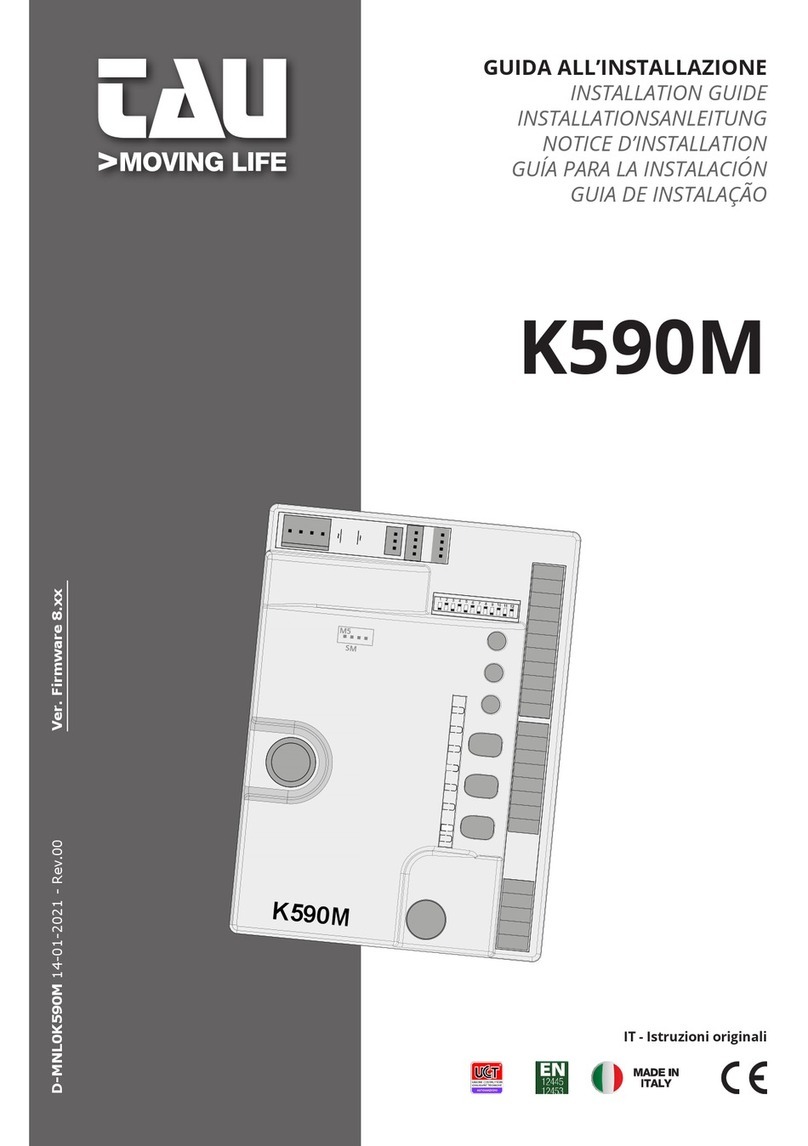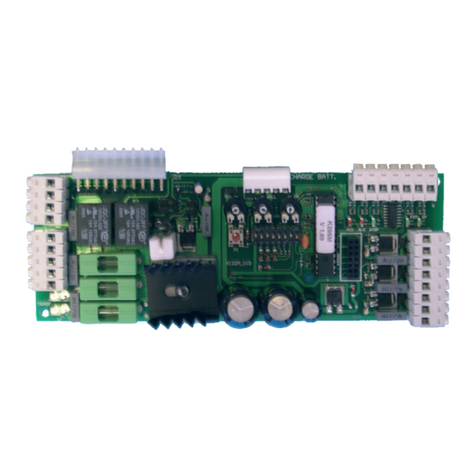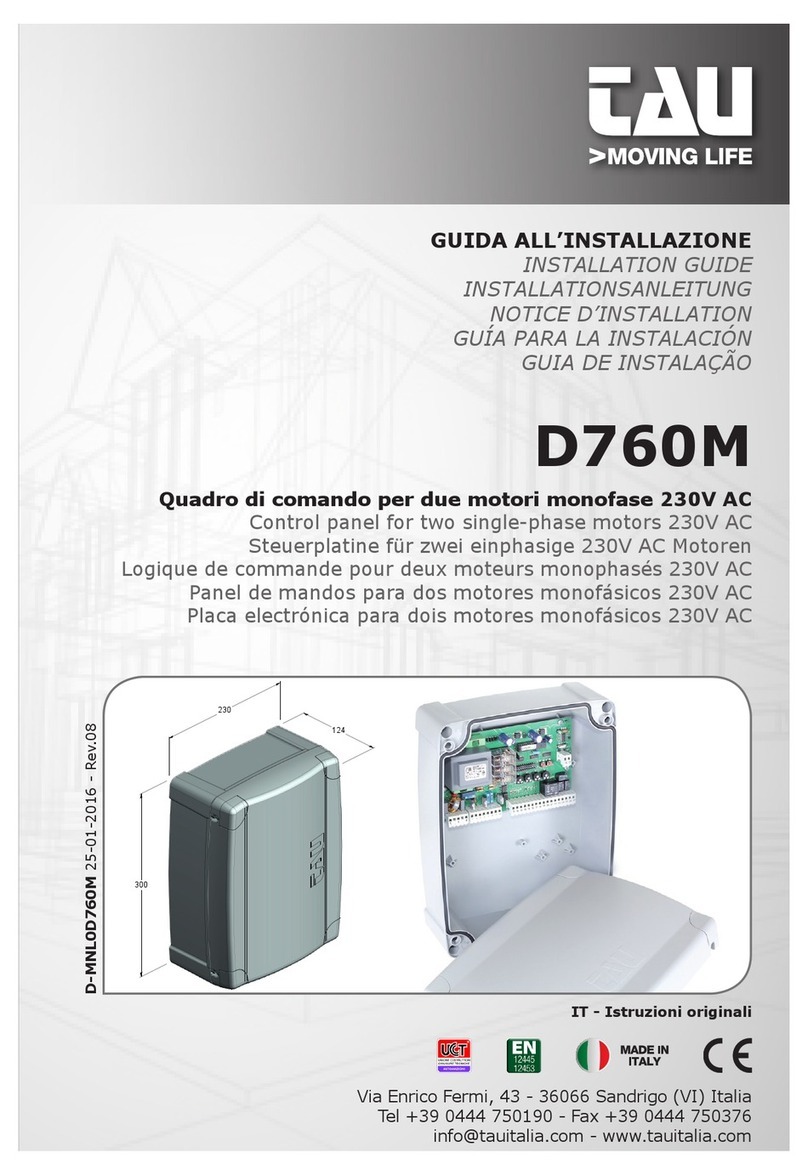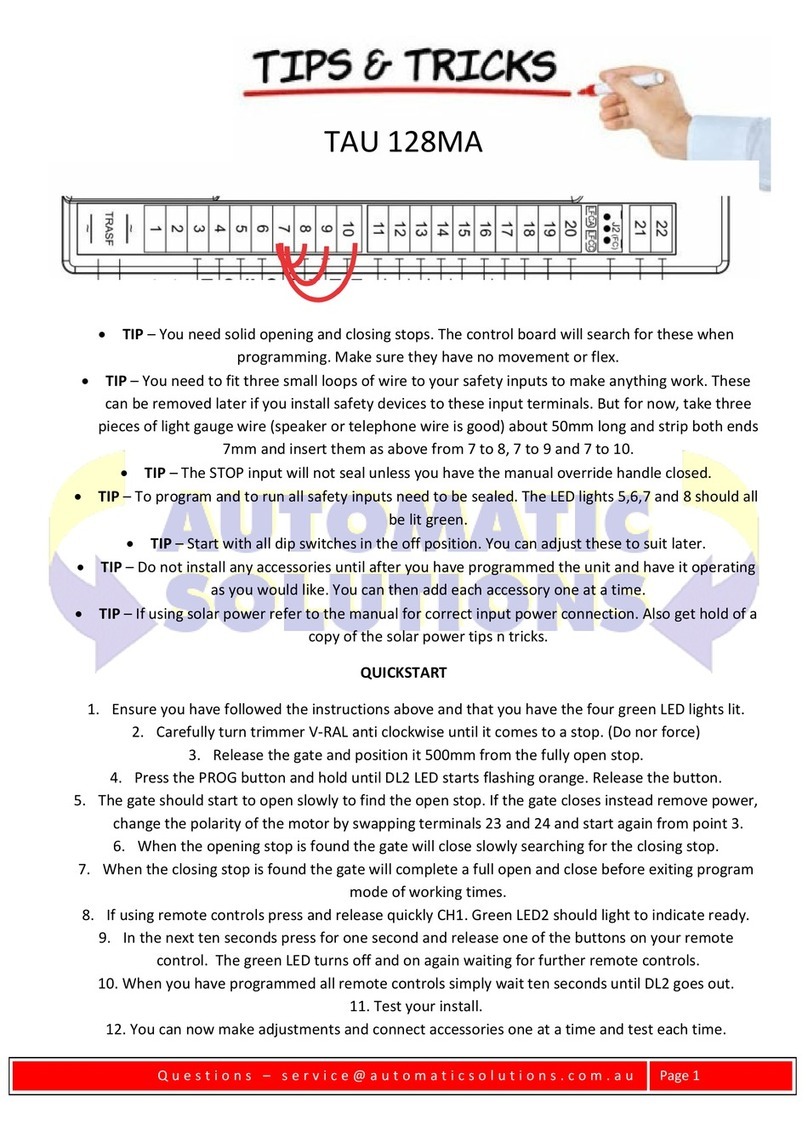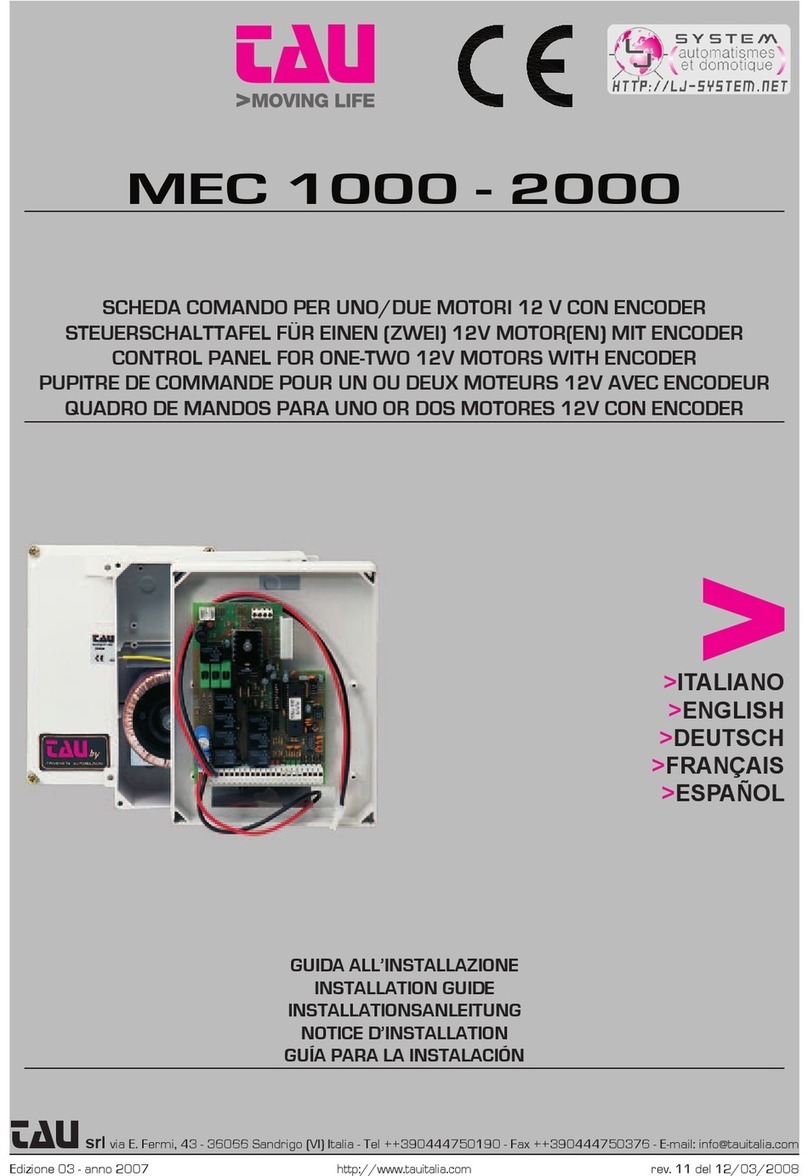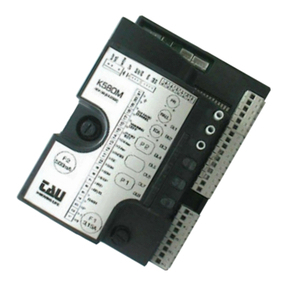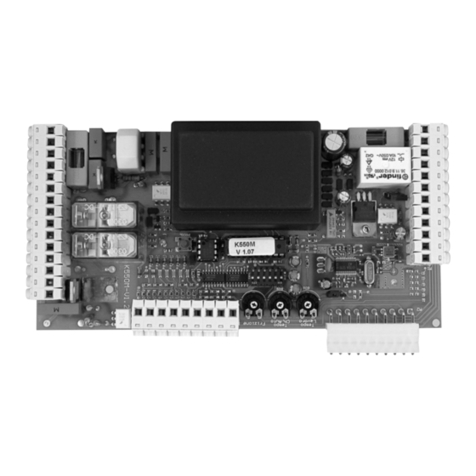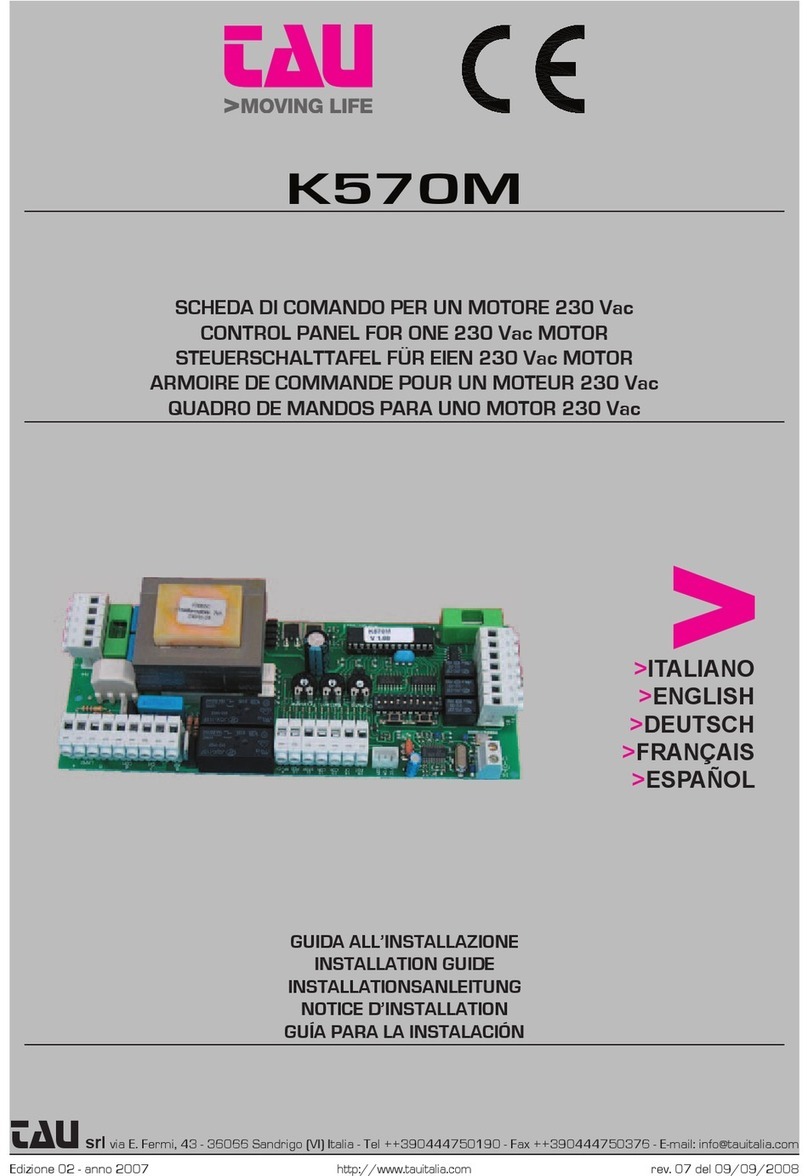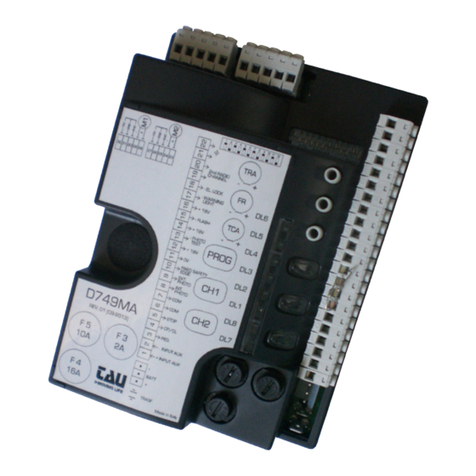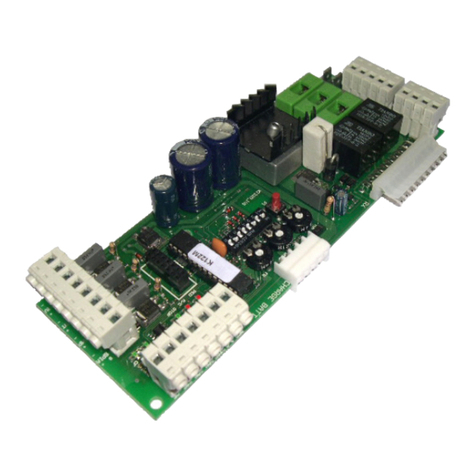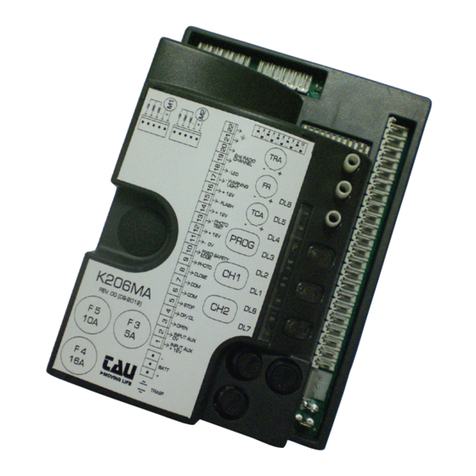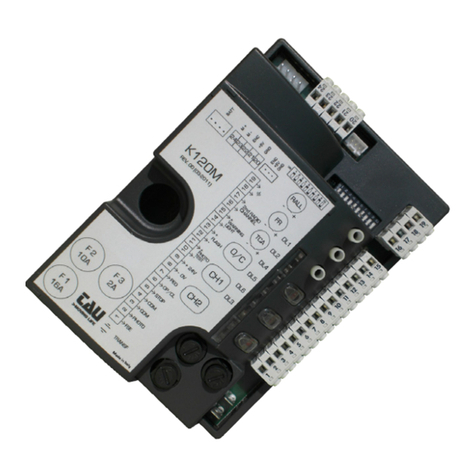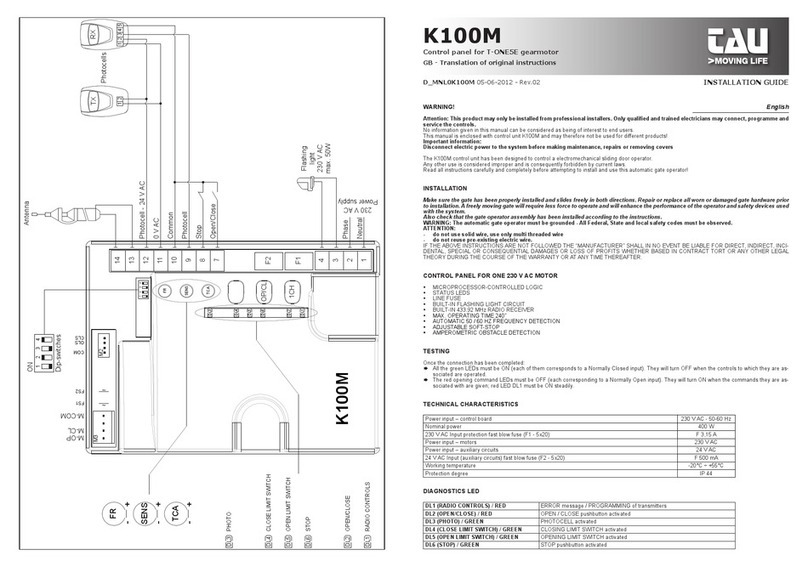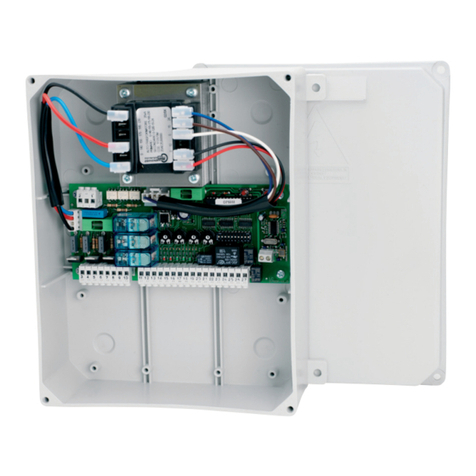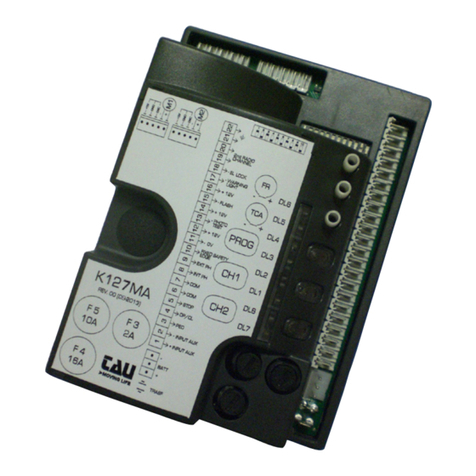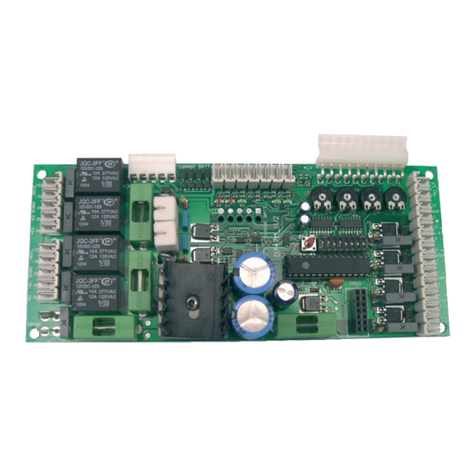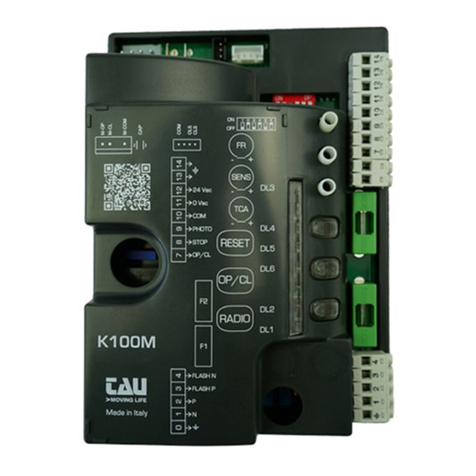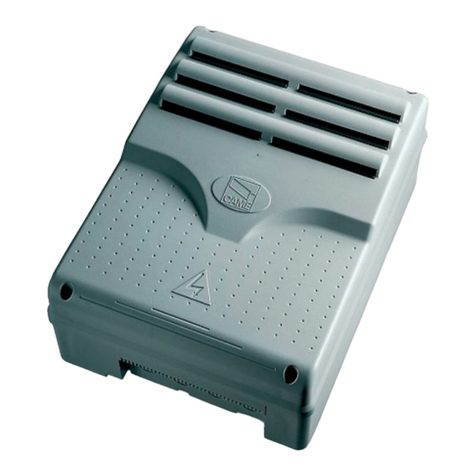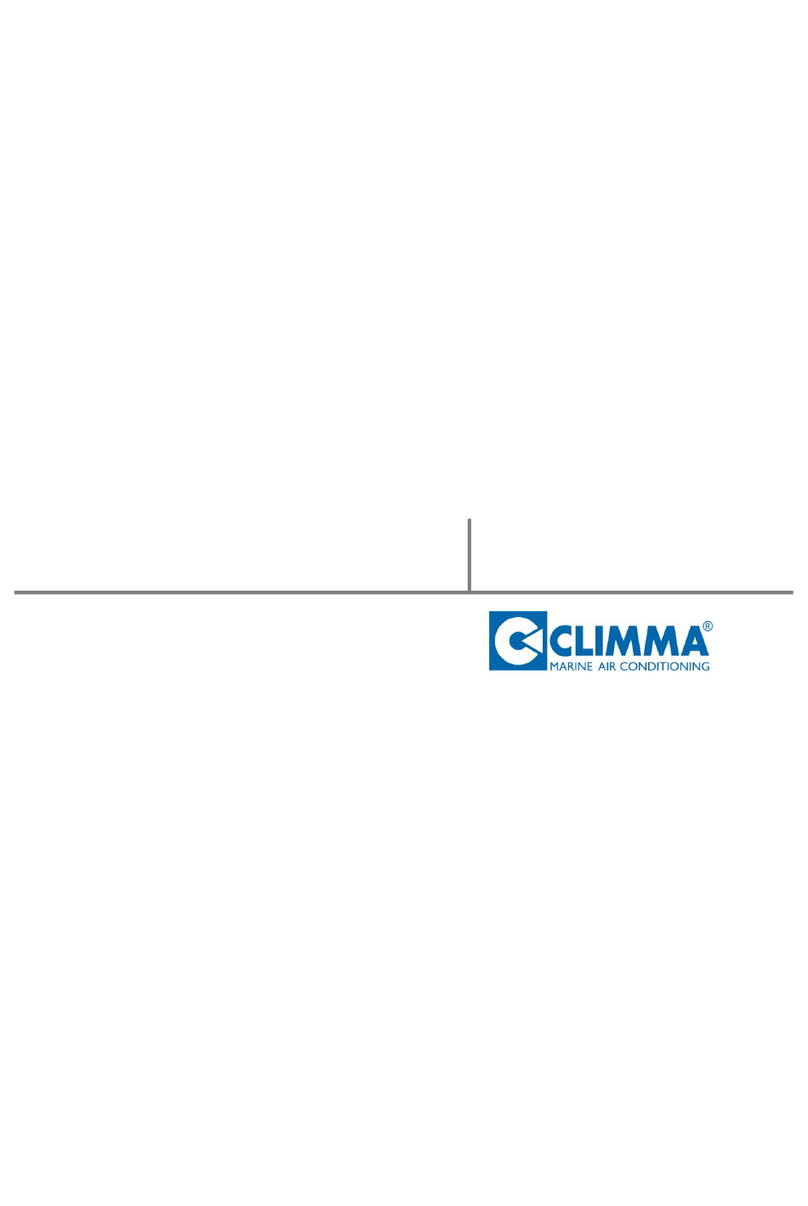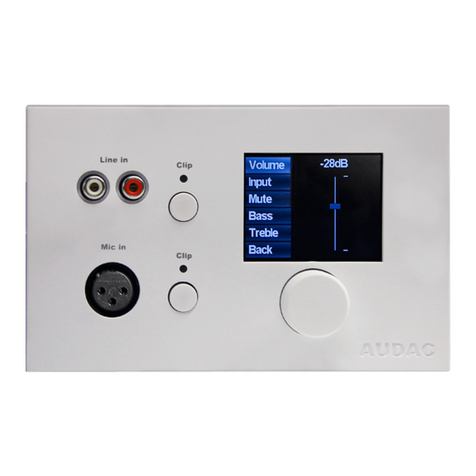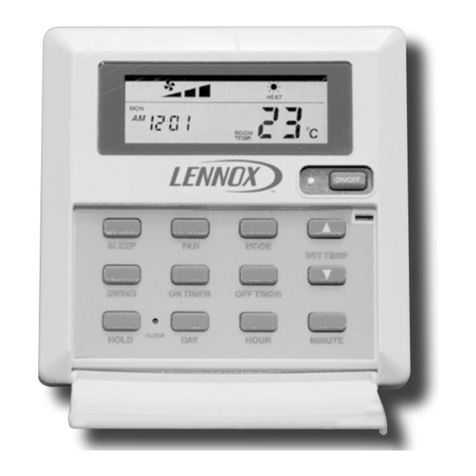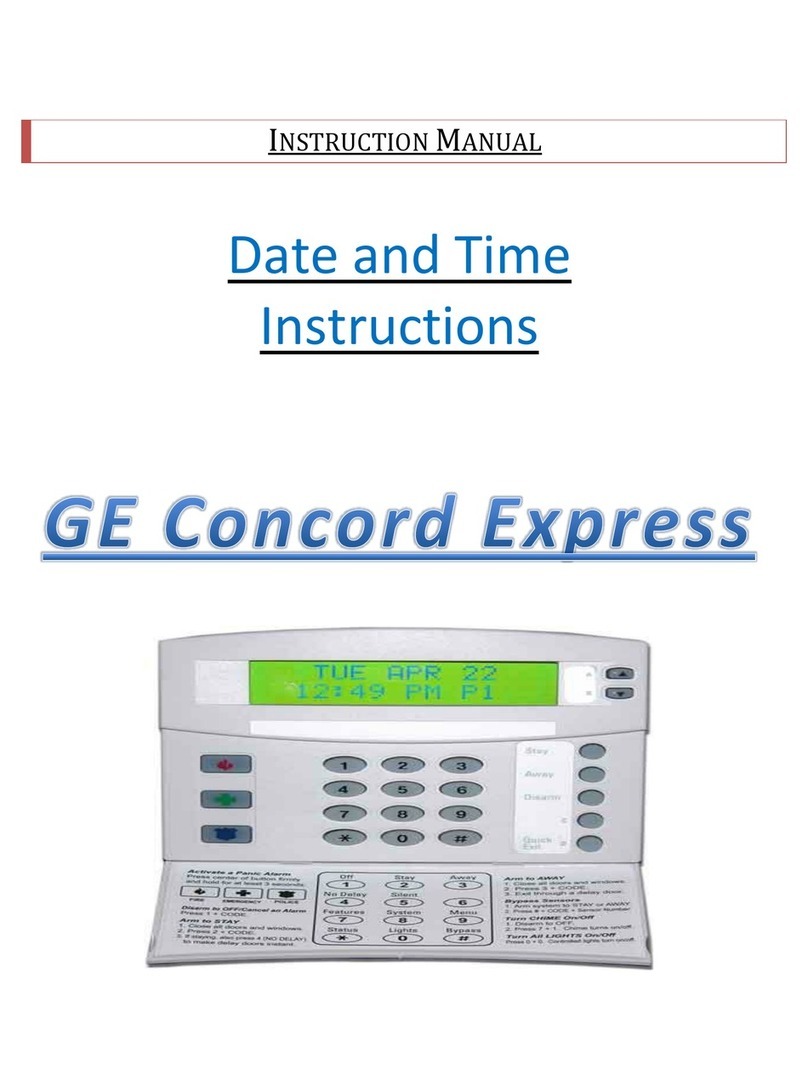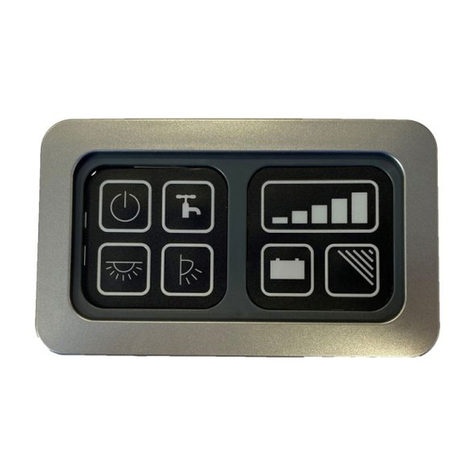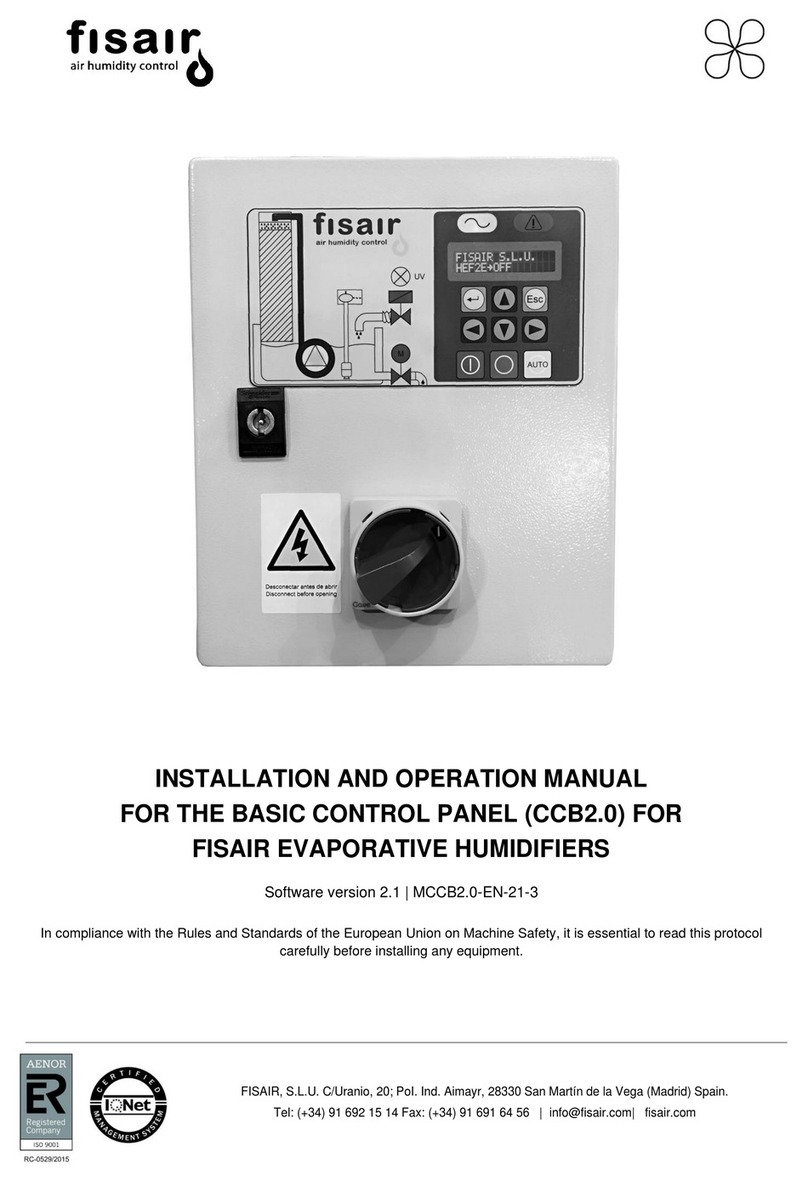tau D703M Manual

1
D703M
Edizione 03 - anno 2007 rev. 16 del 09/02/2007
http://www.tauitalia.com
D703M
TAU srl via E. Fermi, 43 - 36066 Sandrigo (VI) Italia - Tel ++390444750190 - Fax ++390444750376 - E-mail: [email protected]
SCHEDA COMANDO PER MOTORE MONOFASE-TRIFASE 230/400 V ac
CONTROL PANEL FOR 230/400Vac SINGLE/THREE-PHASE MOTOR
SCHALT- UND STEUERTAFEL FÜR EINPHASIGEN-DREIPHASIGEN 230/400 Vac MOTOR
ARMOIRE DE COMMANDE POUR MOTEUR MONOPHASE-TRIPHASE 230/400 V ca
TARJETA DE MANDO PARA MOTOR MONOFÁSICO-TRIFÁSICO 230/400 V ca
GUIDA ALL’INSTALLAZIONE
INSTALLATION GUIDE
INSTALLATIONSANLEITUNG
NOTICE D’INSTALLATION
GUÍA PARA LA INSTALACIÓN
>ITALIANO
>ENGLISH
>DEUTSCH
>FRANÇAIS
>ESPAÑOL

2
D703M
Introduction
This manual has been especially written for use by qualified fitters. No information given in this
manual can be considered as being of interest to end users. This manual is enclosed with control
unit D703M and may therefore not be used for different products!
Important information:
Disconnect the panel from the power supply before opening it.
ATTENTION: Capacitors C5, C6 and C7 located over the fuse “F1A” may be live even after
the panel has been disconnected from the mains supply. Short the 2 terminals of each with
a screwdriver before touching them.
TheD703Mcontrolunithasbeendesignedtocontrolanelectromechanicalgearmotorforautomating
gates and doors of all kinds.
Any other use is considered improper and is consequently forbidden by current laws.
Please note that the automation system you are going to install is classified as “machine
construction” and therefore is included in the application of European directive 89/392 EEC
(Machinery Directive).
This directive includes the following prescriptions:
- Only trained and qualified personnel should install the equipment;
Introduzione
Il presente manuale è destinato solamente al personale tecnico qualificato per l’installazione.
Nessuna informazione contenuta nel presente fascicolo può essere considerata d’interesse per
l’utilizzatore finale. Questo manuale è allegato alla centralina D703M, non deve pertanto essere
utilizzato per prodotti diversi!
Avvertenze importanti:
Togliere l’alimentazione di rete alla scheda prima di accedervi.
ATTENZIONE: i condensatori C5, C6 e C7 posti sopra il fusibile “F1A”, possono essere
carichi anche quando la scheda risulta essere completamente sconnessa dalla rete. Si
cosiglia quindi di cortocircuitare con un cacciavite i 2 terminali degli stessi prima di mettervi
mano.
LacentralinaD703Mèdestinataal comandodiunmotoriduttore elettromeccanicoperl’automazione
di cancelli, porte e portoni.
Ogni altro uso è improprio e, quindi, vietato dalle normative vigenti.
Ènostro dovere ricordarechel’automazionechestate per eseguire,èclassificatacome“costruzione
di una macchina” e quindi ricade nel campo di applicazione della direttiva europea 89/392 CEE
(Direttiva Macchine).
Questa, nei punti essenziali, prevede che:
- l’installazione deve essere eseguita solo da personale qualificato ed esperto;
- chi esegue l’installazione dovrà preventivamente eseguire “l’analisi dei rischi” della macchina;
- l’installazione dovrà essere fatta a “regola d’arte”, applicando cioè le norme;
- infine dovrà essere rilasciata al proprietario della macchina la”dichiarazione di conformità”.
Risulta chiaro quindi che l’installazione ed eventuali interventi di manutenzione devono essere
effettuati solo da personale professionalmente qualificato, in conformità a quanto previsto dalle
leggi, norme o direttive vigenti.
Nella progettazione delle proprie apparecchiture, TAU rispetta le normative applicabili al prodotto
(vedere la dichiarazione di conformità allegata); è fondamentale che anche l’installatore, nel
realizzare gli impianti, prosegua nel rispetto scrupoloso delle norme.
Personale non qualificato o non a conoscenza delle normative applicabili alla categoria dei “can-
celli e porte automatiche” deve assolutamente astenersi dall’eseguire installazioni ed impianti.
Chi non rispetta le normative è responsabile dei danni che l’impianto potrà causare!
si consiglia di leggere attentamente tutte le istruzioni prima di procedere con l’installazione.
Italiano
English

3
D703M
Einleitung
Das vorliegende Handbuch ist nur für technisches, zur Installation qualifiziertes Personal bestimmt.
Die im vorliegenden Heft enthaltenen Informationen sind für den Endbenutzer nicht interessant.
DieseAnleitung liegt der Steuerung D703M bei und darf daher nicht für andere Produkte verwendet
werden!
Wichtige Hinweise:
Die Netzstromversorgung vor dem Zugriff zur Schalt- und Steuertafel abschalten.
ACHTUNG: Die Kondensatoren C5, C6 und C7, über der Sicherung “F1A” angebracht, können
mit Last sein, auch wenn die Schalt- und Steuertafel ganz vom Stromnetz getrennt ist. Bevor
die Kondensatoren berührt werden, sollten daher die beiden Endverschlüsse derselben mit
einem Schraubenzieher kurzgeschlossen werden.
Die Steuerung D703M dient zum Steuern eines elektromechanischen Getriebemotors für die
Automatisierung von Türen und Toren.
Jeder andere Einsatz ist unsachgemäß und daher laut gültiger Vorschriften verboten.
Unsere Pflicht ist, Sie daran zu erinnern, dass die Automatisierung, die Sie ausführen werden, als
„Maschinenkonstruktion”klassiertistunddaher zumAnwendungsbereichderEuropäischenRichtlinie
89/392 (Maschinenrichtlinie) gehört.
Nach den wichtigsten Punkten dieser Vorschrift:
- darf die Installation ausschließlich von erfahrenem Fachpersonal ausgeführt werden;
- muss jener, der die Installation ausführt, vorher eine „Risikoanalyse” der Maschine machen;
- muss die Installation “fachgerecht” bzw. unterAnwendung der Vorschriften ausgeführt sein;
- muss dem Besitzer der Maschine die „Konformitätserklärung” ausgehändigt werden.
Es ist daher offensichtlich, dass Installation und eventuelle Wartungseingriffe nur von beruflich
qualifiziertem Personal in Übereinstimmung mit den Verordnungen der gültigen Gesetze, Normen
und Vorschriften ausgeführt werden dürfen.
Bei der Planung ihrer Apparaturen hält sich TAU an die für das Produkt anwendbaren Vorschriften
(siehe anliegende Konformitätserklärung); von grundlegender Wichtigkeit ist, dass sich auch der
Installateur bei der Durchführung der Anlage genauestens an die Vorschriften hält.
Personal, das nicht qualifiziert ist oder die Vorschriften nicht kennt, die für die Kategorie “auto-
matische Türen und Tore” anwendbar sind, darf Installationen und Anlagen keinesfalls ausfüh-
ren.
Wer sich nicht an die Vorschriften hält, haftet für die Schäden, die von der Anlage verursacht
werden können.
Vor der Installation bitte alleAnweisungen genau lesen.
- the installer must first make a “risk analysis” of the machine;
- the equipment must be installed in a correct and workmanlike manner in compliance with all the
standards concerned;
- after installation, the machine owner must be given the “declaration of conformity”.
This product may only be installed and serviced by qualified personnel in compliance with current,
laws, regulations and directives.
When designing its products, TAU observes all applicable standards (please see the attached
declaration of conformity) but it is of paramount importance that installers strictly observe the same
standards when installing the system.
Unqualified personnel or those who are unaware of the standards applicable to the “automatic
gates and doors” category may not install systems under any circumstances.
Whoever ignores such standards shall be held responsible for any damage caused by the sys-
tem!
Do not install the unit before you have read all the instructions.
Deutsch

4
D703M
Introduction
Le présent manuel est destiné exclusivement au personnel technique qualifié pour l’installation.
Aucune information contenue dans ce fascicule ne peut être considérée comme intéressante pour
l’utilisateur final. Ce manuel est joint à l’armoire de commande D703M, il ne doit donc pas être
utilisé pour des produits différents !
Recommandations importantes :
Couper l’alimentation électrique de l’armoire avant d’y accéder.
ATTENTION : les condensateurs C5, C6 et C7 situés au-dessus du fusible “F1A” peuvent
être chargés même quand l’armoire résulte complètement déconnectée. Il est donc conseillé
de court-circuiter avec un tournevis les deux bornes des condensateurs avant toute
intervention
L’armoire de commande D703M est destinée à la commande d’un motoréducteur électromécanique
pour l’automatisation de portails et de portes.
Toute autre utilisation est impropre et donc interdite par les normes en vigueur.
Nous nous devons de rappeler que l’automatisation que vous vous apprêtez à exécuter est classée
comme “construction d’une machine” et rentre donc dans le domaine d’application de la Directive
Européenne 89/392 CEE (Directive Machines).
Cette directive, dans ses grandes lignes, prévoit que :
- l’installation doit être exécutée exclusivement par du personnel qualifié et expert ;
- qui effectue l’installation devra procéder au préalable à “l’analyse des risques” de la machine ;
- l’installation devra être faite dans les “règles de l’art”, c’est-à-dire en appliquant les normes ;
- l’installateur devra remettre au propriétaire de la machine la “déclaration de conformité”.
Il est donc clair que l’installation et les éventuelles interventions de maintenance doivent être
effectuées exclusivement par du personnel professionnellement qualifié, conformément aux
prescriptions des lois, normes ou directives en vigueur.
Dans le projet de ses appareils, TAU respecte les normes applicables au produit (voir la déclaration
de conformité jointe) ; il est fondamental que l’installateur lui aussi, lorsque qu’il réalise l’installation,
respecte scrupuleusement les normes.
Tout personnel non qualifié ou ne connaissant pas les normes applicables à la catégorie des
“portails et portes automatiques” doit absolument s’abstenir d’effectuer des installations.
Qui ne respecte pas les normes est responsable des dommages que l’installation pourra cau-
ser !
Nous conseillons de lire attentivement toutes les instructions avant de procéder à l’installation.
Français
EspañolIntroducción
Este manual está destinado sólo al personal técnico cualificado para la instalación. Ninguna
información contenida en este manual puede ser considerada interesante para el usuario final. Este
manual acompaña a la central D703M; por lo tanto, ¡no debe utilizarse para otro tipo de producto!
Advertencias importantes:
Corte la alimentación de red a la tarjeta antes de acceder a ella.
ATENCIÓN: los condensadores C5, C6 y C7, situados arriba del fusible “F1A”, también pueden
cargarse cuando la tarjeta está desconectada completamente de la red. Por consiguiente, se
aconseja cortocircuitar con un destornillador los 2 terminales de los condensadores antes
de trabajar sobre ellos.
La central D703M está destinada al accionamiento de un motorreductor electromecánico para la
automatización de cancelas, puertas y portones.
Cualquierotrouso es considerado inadecuado y,por consiguiente,está prohibido por lasnormativas
vigentes.
Es nuestro deber recordarle que la automatización que está por realizar está clasificada como
«construcción de una máquina» y, por consiguiente, entra dentro del campo de aplicación de la
directiva europea 89/392 CEE (Directiva de máquinas).

5
D703M
Dicha normativa, en los puntos fundamentales, prevé que:
- la instalación debe ser efectuada sólo por personal cualificado y experto;
- la persona que efectúe la instalación deberá analizar preventivamente los riesgos de la máqui-
na;
- la instalación deberá ser hecha según las reglas del arte, es decir aplicando las normas;
- por último, habrá que expedir al dueño de la máquina la «declaración de conformidad».
Por consiguiente, es evidente que la instalación y los posibles trabajos de mantenimiento deben
ser efectuados por personal cualificado, de acuerdo con cuanto previsto por las leyes, normas y
directivas vigentes.
Durante el diseño de sus equipos, TAU respeta las normativas aplicables al producto (véase la
declaración de conformidad adjunta); también es fundamental que el instalador, al realizar la
instalación, respete escrupulosamente las normas.
Personal no cualificado, o que no conozca las normativas aplicables a la categoría de las «can-
celas y puertas automáticas», debe abstenerse de efectuar instalaciones.
¡Quien no respeta las normativas es responsable de los daños que la instalación podría pro-
vocar!
se aconseja leer con atención todas las instrucciones antes de proceder con la instalación.
95
200
15

6
D703M
Pastiglia
termica
Master 20T

7
D703M
Italiano
SCHEDA COMANDO PER MOTORE MONOFASE-TRIFASE 230/400 V ac
LOGICA CON MICROPROCESSORE
STATO DEGLI INGRESSI VISUALIZZATO DA LEDs
PROTEZIONE INGRESSO LINEA CON FUSIBILE
FUNZIONE “INGRESSO PEDONALE”
CIRCUITO DI LAMPEGGIO INCORPORATO
FUNZIONE “UOMO PRESENTE”
FRENATURA ELETTRICA
INGRESSO PER TIMER SETTIMANALE
SENSORE AD ENCODER PER RILEVAMENTO OSTACOLI (OPZIONALE)
CONNETTORE PER RICEVENTE
INSTALLAZIONE
L’installazionedovrà essere fattaaregolad’artedapersonalequalificato.LaCasaCostruttricedeclina
ogni responsabilità per danni provocati da imperizia o inosservanza.
In particolare ricordiamo di:
1. posizionare la scheda verticalmente e il più possibile vicino al motoriduttore, evitando lunghi
tratti dei cavi di collegamento;
2. scegliere la sezione dei cavi di potenza (alimentazione, motori, massa e lampeggiante) di al-
meno 1.5 mm² e comunque in ragione degli assorbimenti e della lunghezza dei conduttori. Ciò
detto vale per la rimanenza dei cavi usati da dispositivi di comando e ausiliari con la sola diffe-
renza della sezione minima che è ridotta a 0.5 mm²;
3. collegarsi alla morsettiera in modo da non alterare il grado di protezione offerto dal contenitore,
che deve essere posto in luogo asciutto e protetto;
4. tenere separati i cavi di potenza dai cavi dei circuiti ausiliari e di comando, specialmente per
percorsi lunghi;
5. cortocircuitare i contatti Normalmente Chiusi che non si dovessero utilizzare.
NB: si ricorda l’obbligo di mettere a massa l’impianto nonché di rispettare le normative
sulla sicurezza in vigore in ciascun paese.
COLLAUDO
A collegamento ultimato:
¨ILeds verdi LS devono esseretutti accesi (corrispondonociascuno adun ingresso Normalmente
Chiuso).
¨Si spengono solo quando sono attivi i comandi ai quali sono associati.
¨I Leds rossi LS devono essere tutti spenti (corrispondono ciascuno ad un ingresso Normalmente
Aperto) si accendono solo quando sono attivi i comandi ai quali sono associati.
CARATTERISTICHE TECNICHE
Alimentazione scheda 230/400 Vac - 50÷60Hz
Potenza max. 1,5 Kw ca.
Fusibile rapido protezione linea lampeggiante (F1 - 5x20) F2A - 250Vac
Fusibile rapido protezione linea di alimentazione primaria
(F2-F3-F4 - 5x20) F10A - 250Vac
Tensione circuiti alimentazione motore 230/400 Vac
Tensione alimentazione circuiti dispositivi ausiliari 24 Vac
Fusibile rapido protezione linea 24 V ac (F5 - 5x20) F1,6A - 250Vac
Tensioni alimentazioni circuiti logici 5 Vdc
Temperatura di funzionamento -20°C ÷ + 70 °C
Grado di protezione del contenitore IP43

8
D703M
COLLEGAMENTI ALLA MORSETTIERA
1 - 2 ingresso ALIMENTAZIONE 230 V ac 50÷60 Hz monofase;
1 - 2 - 3 ingresso ALIMENTAZIONE 400 V ac 50÷60 Hz trifase;
N.B. Si rende necessario selezionare la tensione di lavoro mediante il ponticello SW1 pri-
ma di alimentare la scheda.
4 - 5 - 6 uscita MOTORE monofase 230 V ac o trifase 400 V ac, max. 700 W, comune=4, fase
apertura=5, fase chiusura=6, per motori monofase collegare il condensatore tra i morset-
ti 5 e 6;
7 - 8 uscita LAMPEGGIANTE 230 V ac, 20 W max. Il segnale fornito è già opportunamente
modulato per l’uso diretto. La frequenza di lampeggio è leggermente superiore in fase di
chiusura;
9 - 10 ingresso pulsante STOP (contatto normalmente chiuso); il suo intervento provoca l’arre-
sto dell’automazione.Al successivo comando l’automazione esegue una manovra oppo-
sta alla precedente (comune=9);
9 - 11 ingresso pulsante PEDONALE (contatto normalmente aperto); consente l’apertura limi-
tata (1 mt. ca.) dell’automazione per consentire il passaggio pedonale (comune=9);
12 - 13 ingresso pulsante APRE/CHIUDE (contatto normalmente aperto); per le modalità d’uso
vedi le funzioni dei dip-switches nr 2 e nr 8 (comune=12);
12 - 14 ingresso pulsante APRE (contatto normalmente aperto); per le modalità d’uso vedi le
funzioni del dip-switch nr 3 (comune=12);
12 - 15 ingresso pulsante CHIUDE (contatto normalmente aperto); per le modalità d’uso vedi le
funzioni del dip-switch nr 3 (comune=12);
16 - 17 ingresso COSTA DI SICUREZZA FISSA (contatto normalmente chiuso); funziona solo
durante la fase di apertura dell’automazione provocandone l’arresto temporaneo a cui
succede una richiusura di 20 cm ca. Per riprendere il funzionamento è necessario un
comando manuale (comune=16);
16 - 18 ingresso FOTOCELLULE o DISPOSITIVI DI SICUREZZA (contatto normalmente chiu-
so); il loro intervento in fase di chiusura provoca l’arresto seguito dalla totale riapertura
del cancello. In fase di apertura provoca la fermata temporanea del cancello fino a rimo-
zione dell’ostacolo rilevato (se programmato, dip-switch nr 9 in ON), (comune=16);
N.B. Il trasmittente della fotocellula deve sempre essere collegato (morsetti nr 27 e nr 28),
in quanto su di esso si effettua la verifica del sistema di sicurezza (Fototest), quindi,
senza questo collegamento, la centralina non funziona. Per eliminare la verifica del
sistema di sicurezza, porre il dip-switch nr 6 in OFF.
19 - 20 ingresso FINE CORSA CHIUSURA (contatto normalmente chiuso), (comune=19);
19 - 21 ingresso FINE CORSAAPERTURA(contatto normalmente chiuso), (comune=19);
N.B. La termoprotezione (solo per il MASTER20T) deve essere cablata in serie al comune
(morsetto 19) dei finecorsa.

9
D703M
22 - 23 alimentazione ENCODER (comune=22-BLU) (+5V=23-MARRONE); il funzionamento
dell’ENCODER è regolato dal dip-switch nr 5;
24 segnale ENCODER (BIANCO), il funzionamento dell’ENCODER è regolato dal dip-
switch nr 5 (solo per motori provvisti di ENCODER);
25 - 26 uscita SPIA CANCELLO APERTO; 24 V ac, max 3W; la spia si illumina con la stessa
frequenza del lampeggiante per tutta la corsa in apertura e in chiusura per rimanere,
accesa se il cancello è aperto, spenta a raggiungimento del FINE CORSA CHIUSURA
(FCC);
27 - 28 uscita alimentazione 24 V ac (solo per il trasmittente della fotocellula) max. nr. 1
trasmettitore fotocellule;
29 - 30 uscita alimentazione ausiliaria 24 V ac (alimentazione fotocellule o altri dispositivi);
31 - 32 ingresso ANTENNA (segnale=31, massa=32) (solo per RX 40,665MHz);
33 - 34 uscita 2° CANALE RADIO;
C connettore per l’inserzione della scheda radio.
REGOLAZIONI LOGICHE
TRIMMER
T.L. regolazione Tempo di Lavoro: da 5 a 240 secondi ca.;
T.C.A. regolazione Tempo di Chiusura Automatica: da 5 a 120 secondi ca. (vedi dip-switch nr.
1);
FR. regolazione sensibilità rilevamento ostacoli (solo per motori provvisti di Encoder).
NOTA: ruotando i TRIMMER in senso orario si aumentano le regolazioni, viceversa, ruo-
tandoli in senso antiorario, diminuiscono.
Dip switch
1 on: ad apertura completata, la chiusura del cancello è automatica trascorso un tempo impostato
sul trimmer T.C.A.;
off: la chiusura necessita di un comando manuale;
2 on: ad automazione funzionante, una sequenza di comandi di apertura/chiusura induce il can-
cello ad una APERTURA-CHIUSURA-APERTURA-CHIUSURA, etc.
off: nelle stesse condizioni, la stessa sequenza di comandi induce il cancello ad una APER-
TURA-STOP-CHIUSURA-STOP-APERTURA-STOP (funzione passo-passo) (vedi anche dip
switch 8);
3 on: Uomo Presente; l’automazione continuerà ad aprire o a chiudere fino a quando si manterrà
premuto il pulsante APRI o il pulsante CHIUDI. Al rilascio dello stesso si otterrà l’arresto del
motoriduttore;
off: normale (o impulsivo); ad un comando sul pulsante APRI, CHIUDI o PP, l’automazione
effettuerà un’apertura o una chiusura completa;
N.B. In modalità Uomo Presente l’ingresso PP (n° 13) viene escluso, così come la radio
ricevente.
4non utilizzato;
5 on: encoder escluso (condizione obbligata se il motore non è provvisto di Encoder);
off: encoder inserito (solo per motori provvisti di encoder);
6 on: la funzione prelampeggio e “verifica delle fotocellule” è inserita;
off: la funzione prelampeggio e “verifica delle fotocellule” è disinserita;

10
D703M
7 on: in seguito all’intervento del contatto fotocellula (ingresso 16 - 18), l’automazione si chiude
dopo 5 secondi;
off: funzione disinserita;
8 on: il cancello si comporta come stabilito dal dip switch nr. 2
off: il cancello ignora i comandi di chiusura durante l’apertura;
9 on: durante la fase di apertura la fotocellula interviene arrestando il cancello fino a rimozione
dell’ostacolo rilevato. In fase di chiusura provoca l’arresto seguito dalla totale riapertura del
cancello;
off: durante la fase di apertura la fotocellula non interviene, mentre in fase di chiusura si com-
porta come in modalità on;
10 on: frenata attiva;
off: frenata esclusa;
N.B. Il sistema di frenata si aziona ogni qualvolta il motore deve fermasi (FCC - FCA - STOP
- inversione di marcia) e attenua l’inerzia accumulata dal cancello durante la corsa.
Funzione orologio:
È possibile utilizzare un timer (esempio settimanale) collegato all’ingresso del pulsante apre-
chiude per mantenere aperto il cancello in determinate fascie orarie e permetterne poi la richiusura
automaitca.
LED DI DIAGNOSI
DL1 led verde di segnalazione pulsante STOP
DL2 led rosso di segnalazione pulsante PEDONALE
DL3 led rosso di segnalazione pulsante PASSO-PASSO
DL4 led rosso di segnalazione pulsante APRE
DL5 led rosso di segnalazione pulsante CHIUDE
DL6 led verde di segnalazione BORDO SENSIBILE
DL7 led verde di segnalazione FOTOCELLULA
DL8 led verde di segnalazione FINECORSA IN CHIUSURA
DL9 led verde di segnalazione FINECORSA IN APERTURA
MALFUNZIONAMENTI: POSSIBILI CAUSE E RIMEDI
1_ L’automazione non parte
a_ Verificare con lo strumento (Multimetro) la presenza dell’alimentazione 230Vac;
b_ Impostare il ponte SW1 sulla giusta tensione disponibile;
c_ Verificare che i contatti N.C. della scheda siano effettivamente normalmente chiusi (5 led
verdi accesi);

11
D703M
d_ Impostare il dip 3 (funzione uomo presente) su OFF, il dip 5 (encoder) su ON, il dip 6 (foto-
test) su OFF;
e_ Controllare con lo strumento (Multimetro) che i fusibili siano integri.
2_ Il radiocomando ha poca portata
a_ Collegare l’antenna radio sui morsetti presenti sulla scheda ricevente e non sui morsetti 31-
32 della scheda di comando (per frequenza 433,92 MHz);
b_ Controllare che il collegamento della massa e del segnale dell’antenna non sia invertito;
c_ Non eseguire giunzioni per allungare il cavo dell’antenna;
d_ Non installare l’antenna in posizioni basse o in posizioni nascoste dalla muratura o dal pila-
stro;
e_ Controllare lo stato delle pile del radiocomando.
3_ Il cancello si apre al contrario
a_ Invertire tra loro i collegamenti del motore sulla morsettiera (morsetti 5 e 6);
Di conseguenza, invertire il collegamento dei finecorsa (morsetti 20 e 21).

12
D703M
CONTROL PANEL FOR 230/400Vac SINGLE/THREE-PHASE MOTOR
MICROPROCESSOR-CONTROLLED LOGIC
INPUT STATUS LED’S
LINE INPUT FUSE
“PEDESTRIAN ENTRY” FUNCTION
BUILT-IN FLASHING LIGHT CIRCUIT
“MAN PRESENT” FUNCTION
ELECTRIC BRAKING
WEEKLY TIMER INPUT
ENCODER SENSOR FOR OBSTACLE DETECTION (OPTIONALACCESSORY)
RECEIVER CONNECTOR
INSTALLATION
Thisproductmust be correctly installed by a qualifiedfitter.The maker declines all liabilityfor damage
caused by incapacity or neglect.
In particular:
1. position the board vertically and as near as possible to the gear motor, taking care to keep the
connection cables as short as possible;
2. make sure the cross-section of the power cables (power input, motors, earth and flashing light)
is at least 1.5 mm² and, in any case, sufficient for the absorption and length of the wires. The
above also applies to the other cables used by control and auxiliary devices except that the
minimum cross-section is reduced to 0.5 mm²;
3. make connections to the terminal board so as not to alter the level of protection offered by the
container which must be installed in a dry and protected place;
4. keep the power circuits separate from the control and auxiliary circuits, especially if the cables
are long;
5. short any unused Normally Closed contacts.
NB: the product must be properly earthed and the safety regulations in force in the coun-
try of installation must be observed.
TESTING
When all connections have been made:
¨All the green LS LED’s must be on (each corresponds to a Normally Closed input).
¨They only turn off when the commands they are associated with are active.
¨All the red LS LED’s must be off (each corresponds to a Normally Open input) they only turn on
when the commands they are associated with are active.
TECHNICAL CHARACTERISTICS
Power input to board 230/400 Vac - 50÷60Hz
Maximum power 1,5 Kw ca.
Flashing light rapid fuse (F1 - 5x20) F2A - 250Vac
Primary input line rapid fuse (F2-F3-F4 - 5x20) F10A - 250Vac
Input voltage of motor circuits 230/400 Vac
Input voltage of auxiliary circuits 24 Vac
24Vac line rapid fuse (F5 - 5x20) F1,6A - 250Vac
Logic circuit input voltage 5 Vdc
Working temperature -20°C ÷ + 70 °C
Box protected to IP43
English

13
D703M
TERMINAL BOARD CONNECTIONS
1 - 2 POWER input 230Vac, 50Hz, single-phase;
1 - 2 - 3 POWER input 400Vac, 50Hz, three-phase;
N.B. Select working voltage with jumper SW1 before powering the board.
4 - 5 - 6 MOTOR output single-phase 230Vac or three-phase 400Vac, max. 700W, common=4,
opening phase=5, closing phase=6, for single-phase motors connect the capacitor be-
tween terminals 5 and 6;
7 - 8 FLASHING LIGHT output 230Vac, 20W max. The signal is already modulated for direct
use. Flashing frequency increases slightly during closing;
9 - 10 STOPbutton input (normally closed contact); this stops the automatic system.At the next
command, the opposite operation to the previous one is performed (common=9);
9 - 11 PEDESTRIAN button input (normally open contact); partially opens the automatic sys-
tem (by about 1 m) to allow pedestrians to pass by (common=9);
12 - 13 OPEN/CLOSE button input (contact normally open); for operating information see dip
switch 2 and 8 functions;
12 - 14 OPEN button input (contact normally open); for operating information see dip switch 3
functions (common=12);
12 - 15 CLOSE button input (contact normally open); for operating information see dip switch 3
functions (common=12);
16 - 17 FIXED SAFETY EDGE input (normally closed contact); only works during the opening
phase by temporarily stopping the gate and then closing it again by approx. 20 cm. A
manual command is required to continue operation (common=16);
16 - 18 PHOTOCELL or SAFETY DEVICES input (normally closed contact); if these trigger dur-
ing the closing phase, the gate stops and then completely reopens. During the opening
phase it temporarily stops the gate until the detected obstacle has been removed (if
programmed, dip switch 9 to ON), (common=16);
N.B. the photocell transmitter must always be connected (terminals 27 and 28) as it is
checked by the safety system; the control unit will not work if it is disconnected. To
disable the safety system move dip switch 6 to OFF.
19 - 20 CLOSE LIMIT SWITCH input (normally closed contact), (common=19);
19 - 21 OPEN LIMIT SWITCH input (normally closed contact), (common=19);
N.B. The thermal protection (for MASTER20T only) must be wired in series to the common
of the limit switch (terminal 19).
22 - 23 ENCODER power input (common=22-BLEU) (+5V=23-BROWN); the operation of the
ENCODER is governed by dip switch 5;

14
D703M
24 ENCODER signal (WHITE), ENCODER operation is governed by dip switch 5 (only for
motors with ENCODER);
25 - 26 GATE OPEN LED output; 24Vac, max. 3W; the LED lights up at the same frequency as
the flashing light throughout the opening and closing manoeuvres; it then stays on when
the OPEN LIMIT SWITCH (FCA) is reached and switches off when the CLOSED LIMIT
SWITCH (FCC) is reached;
27 - 28 24Vac power output (only for the photocell transmitter) max. no. 1 photocell transmitter;
29 - 30 24Vac auxiliary power output (power input to photocells or other devices);
31 - 32 AERIAL input (earth=31, signal=32) (only for RX 40.665MHz);
33 - 34 2nd RADIO CHANNEL output;
C radio board connector.
LOGIC ADJUSTMENTS
TRIMMER
T.L. Work Time adjustment: from approx. 5 to 240 seconds;
T.C.A. Automatic Closing Time adjustment: from approx. 5 to 120 seconds (see dip switch 1);
FR. obstacle detection sensitivity adjustment (only for motors with encoder).
N.B.: turn the TRIMMER clockwise to increase adjustments; turn it anticlockwise to de-
crease.
Dip switches
1 on: after opening, the gate automatically closes when the delay set on the T.C.A. trimmer ex-
pires;
off: a command is required to close the gate;
2 on: with automatic closing enabled, a sequence of open/close commands causes the gate to
OPEN-CLOSE-OPEN-CLOSE etc.;
off: in the same conditions, the same command sequence causes the gate to OPEN-STOP-
CLOSE-STOP-OPEN-STOP (step-by-step) (see also dip switch 9);
3 on: Man Present; the automation system will continue to open or close as long as the OPEN or
CLOSE buttons are held down. The gear motor will stop when the button is released;
off: normal (or pulse); when the OPEN, CLOSE or the PP button is pushed, the automatic sys-
tem performs a complete opening or closing manoeuvre;
N.B. In the Man Present mode, the PP input (n° 13) is disabled, as is the radio receiver.
4not used;
5 on: encoder disabled (obligatory if the motor is not fitted with an encoder);
off: encoder enabled (only for motors with encoder);
6 on: pre-flashing and “photocell test” function enabled;
off: pre-flashing and “photocell test” function disabled;
7 on: after the photocell contact triggers (input 16 - 18), the automation system closes after 5
seconds;
off: function disabled;
8 on: the gate works as set by dip switch 2
off: the gate ignores the close command during the opening cycle;
9 on: during opening, the photocell cuts in to stop the gate until the obstacle is removed. During
closing, it stops the gate and then totally reopens it.
off: during opening, the photocell does not trigger while during closing, it behaves as if the dip
switch were on;
10 on: braking enabled;
off: braking disabled;
N.B. The braking system activates whenever the motor must stop (FCC - FCA - STOP –
change of direction) and reduces the inertia accumulated by the gear motor during
movement.

15
D703M
Clock function:
A timer can be connected to the open-close pushbutton in order to keep the gate open at certain
times during the day, after which it reverts to automatic closing.
DIAGNOSTICS LED
DL1 STOP button green LED signal
DL2 PEDESTRIAN button red LED signal
DL3 STEP BY STEP button red LED signal
DL4 OPEN button red LED signal
DL5 CLOSE button red LED signal
DL6 SENSITIVE EDGE green LED signal
DL7 PHOTOCELL green LED signal
DL8 CLOSE LIMIT SWITCH green LED signal
DL9 OPEN LIMIT SWITCH green LED signal
MALFUNCTIONS: POSSIBLE CAUSES AND SOLUTION
1_ The automation does not start
a_ Check there is 230Vac power supply with the multimeter;
b_ Set the SW1 jumper on the correct available voltage;
c_ Check that the NC contacts of the card are actually normally closed (5 green LEDs on);
d_ Set the dip 3 (man present function) to OFF, dip 5 (encoder) to ON, dip 6 (phototest) to
OFF;
e_ Check that the fuses are intact with the multimeter.
2_ The radio control has very little range
a_ Connect the radio aerial to the terminals of the receiver card and not to terminals 31-32 of
the control card (for frequency 433,92 MHz);
b_ Check that the ground and the aerial signal connections have not been inverted;
c_ Do not make joints to increase the length of the aerial wire;
d_ Do not install the aerial in a low position or behind walls or pillars;
e_ Check the state of the radio control batteries.
3_ The gate opens the wrong way
a_ Invert the motor connections on the terminal block (terminals 5 and 6);
Consequently, invert the connections of the limit switches (terminals 20 and 21).

16
D703M
Deutsch
SCHALT- UND STEUERTAFEL FÜR EINPHASIGEN-DREIPHASIGEN 230/400 Vac
MOTOR
MIKROPROZESSORLOGIK
STATUSANZEIGE DER EINGÄNGE DURCH LEDs
SCHUTZ DES LINIENEINGANGS MIT SICHERUNG
“GEHFLÜGEL”-FUNKTION
EINGEBAUTER BLINKKREISLAUF
“TODMANN”-FUNKTION
ELEKTROBREMSE
EINGANG FÜR WOCHENTIMER
ENCODER ZUR WAHRNEHMUNG VON HINDERNISSEN (OPTIONAL)
VERBINDER FÜR EMPFÄNGER
INSTALLATION
Die Installation muss fachgerecht durch qualifiziertes Personal ausgeführt werden. Der Hersteller
übernimmt keinerlei Haftung für Schäden aufgrund von Unerfahrenheit oder Nichtbeachtung.
Insbesondere erinnern wir an folgendes:
1. die Steuerkarte senkrecht und so nah wie möglich am Getriebemotor anbringen; lange Strecken
der Verbindungskabel sind zu vermeiden;
2. Einen Querschnitt der Leistungskabel (Versorgung, Motoren, Masse und Blinkleuchte) von min-
destens 1.5 mm² wählen, immer inAbhängigkeit von den Stromaufnahmen und der Leiterlänge.
Dies gilt auch für die restlichen Kabel, die von Steuer- und Hilfsvorrichtungen benutzt werden,
mit dem Unterschied, dass für diese der Mindestquerschnitt 0.5 mm²sein darf;
3. den Anschluss am Klemmenbrett so ausführen, dass die Schutzart des Gehäuses, das trocken
und geschützt installiert werden muss, nicht geändert wird;
4. die Leistungskabel von den Kabeln der Hilfs- und Steuerkreise getrennt halten, insbesondere
wenn es sich um lange Strecken handelt;
5. gewöhnlich geschlossene Kontakte, die nicht benutzt sind, müssen kurzgeschlossen werden.
NB: es wird daran erinnert, dass es Pflicht ist, die Anlage zu ersten und die im jeweiligen
Land gültigen Sicherheitsvorschriften einzuhalten.
ENDPRÜFUNG
Nach Beendigung der Anschlüsse:
¨müssen alle grünen LEDs LS leuchten (jede LED entspricht einem gewöhnlich geschlossenen
Eingang).
¨schaltendieseLEDsnurab,wenndieSteuervorrichtungenaktiviertsind,mitdenen sie kombiniert
sind.
¨müssenalle roten LEDsLSabgeschaltetsein (jede LEDentsprichteinemgewöhnlich geöffnetenen
Eingang). Diese LEDs leuchten nur auf, wenn die Steuervorrichtungen aktiviert sind, mit denen
sie kombiniert sind.
TECHNISCHE MERKMALE
Versorgung der Schalt- und Steuertafel 230/400 Vac - 50÷60Hz
Höchstleistung 1,5 Kw ca.
Schnellsicherung zum Schutz der Linie der Blinkleuchte (F1 - 5x20) F2A - 250Vac
Schnellsicherung zum Schutz der Hauptversorgungslinie
(F2-F3-F4 - 5x20) F10A - 250Vac
Spannung der Motorversorgungskreise 230/400 Vac
Spannung der Versorgungskreise der Hilfsvorrichtungen 24 Vac
Schnellsicherung zum Schutz der 24 Vac Linie (F5 - 5x20) F1,6A - 250Vac
Versorgungsspannungen der logischen Kreisläufe 5 Vdc
Betriebstemperatur -20°C ÷ + 70 °C
Schutzart des Gehäuses IP43

17
D703M
ANSCHLÜSSE AM KLEMMENBRETT
1 - 2 Eingang der VERSORGUNG 230 Vac 50Hz einphasig;
1 - 2 - 3 Eingang der VERSORGUNG 400 Vac 50 Hz dreiphasig;
N.B. Die Betriebsspannung muss vor der Versorgung der Steuerkarte mit Hilfe der Über-
brückung SW1 ausgewählt werden.
4 - 5 - 6 Ausgang für einphasigen 230 Vac oder für dreiphasigen 400Vac MOTOR, max. 700 W,
gemeinsamer Leiter=4, Phase für Öffnung=5, Phase für Schließung=6, für einphasige
Motoren, den Kondensator zwischen den Klemmen 5 und 6 anschließen;
7 - 8 Ausgang für 230 Vac BLINKLEUCHTE, max. 20 W. Das gelieferte Signal ist bereits für
Direktsteuerung moduliert. Die Blinkfrequenz ist in Schließung etwas schneller;
9 - 10 Eingang für STOP-Taste (gewöhnlich geschlossener Kontakt); seine Auslösung verur-
sacht das Anhalten der Automatisierung. Beim nächsten Steuerbefehl führt die Auto-
matisierung eine Bewegung aus, die entgegengesetzt zur vorherigen ist (gemeinsamer
Leiter=9);
9 - 11 Eingang für GEHFLÜGEL-Taste (gewöhnlich geöffneter Kontakt); ermöglicht eine be-
grenzte Öffnung (ca. 1 m) derAutomatisierung für den Durchgang von Fußgängern (ge-
meinsamer Leiter=9);
12 - 13 Eingang für Taste ÖFFNET/SCHLIEßT (gewöhnlich geöffneter Kontakt); für den Ge-
brauch siehe die Funktionen der Dip-Switches Nr. 2 und 8 2 (gemeinsamer Leiter=12);
12 - 14 Eingang für Taste ÖFFNET (gewöhnlich geöffneter Kontakt); für den Gebrauch siehe die
Funktionen des Dip-Switch Nr. 3 (gemeinsamer Leiter=12);
12 - 15 Eingang für Taste SCHLIEßT (gewöhnlich geöffneter Kontakt); für den Gebrauch siehe
die Funktionen des Dip-Switch Nr. 3 (gemeinsamer Leiter=12);
16 - 17 EingangfürFESTE SICHERHEITSLEISTE (gewöhnlich geschlossener Kontakt); funktio-
niert nur während der Öffnung derAutomatisierung und verursacht ein vorübergehendes
Anhalten, dem ein erneutes Schließen von ca. 20 cm folgt. Um den Betrieb fortzusetzen,
muss ein manueller Steuerbefehl gegeben werden (gemeinsamer Leiter=16);
16 - 18 Eingang für FOTOZELLEN oder SICHERHEITSVORRICHTUNGEN (gewöhnlich ge-
schlossener Kontakt); ihreAuslösung in Schließung verursacht einAnhalten, gefolgt von
einer vollständigen Öffnung desTors. In Öffnung wird das vorübergehende Anhalten des
Tors bis zur Entfernung des wahrgenommenen Hindernisses verursacht (falls program-
miert, muss Dip-Switch Nr. 9 auf ON sein (gemeinsamer Leiter=16);
N.B. Der Fotozellensender muss immer angeschlossen sein (Klemmen Nr. 27 und 28), da
an ihm die Überprüfung des Sicherheitssystems erfolgt; ohne diesenAnschluss funk-
tioniert die Steuerung daher nicht. Um die Überprüfung des Sicherheitssystems nicht
auszuführen, muss Dip-Switch Nr. 6 auf OFF gestellt werden.
19 - 20 Eingang für ENDSCHALTER IN SCHLIEßUNG (gewöhnlich geschlossener Kontakt),
(gemeinsamer Leiter=19);

18
D703M
19 - 21 Eingang für ENDSCHALTER IN ÖFFNUNG (gewöhnlich geschlossener Kontakt), (ge-
meinsamer Leiter=19);
N.B. Der Wärmeschutz (nur für MASTER20T) muss mit dem gemeinsamen Leiter (Klemme
19) der Endschalter seriengeschaltet sein.
22 - 23 Versorgung für ENCODER (gemeinsamer Leiter=22-BLAU) (+5V=23-BRAUN); der Be-
trieb des ENCODERS wird von Dip-Switch Nr 5 geregelt;
24 ENCODERSIGNAL (WEIß), der Betrieb des ENCODERS wird von Dip-Switch Nr 5
geregelt (nur für Motoren mit ENCODER);
25 - 26 Ausgang für LEUCHTMELDER TOR GEÖFFNET; 24 Vac, max 3W; der Leuchtmelder
blinkt während des gesamten Laufs in Öffnung und Schließung mit derselben Frequenz
der Blinkleuchte; wenn das Tor geöffnet ist, bleibt er fest leuchtend und erlischt bei
Erreichung des ENDSCHALTERS IN SCHLIEßUNG (FCC);
27 - 28 Ausgang für 24 Vac Versorgung (nur für den Fotozellensender) max. Nr. 1
Fotozellensender;
29 - 30 Ausgang für 24 Vac Hilfsversorgung (Versorgung von Fotozellen oder sonstiger
Vorrichtungen);
31 - 32 Eingang für ANTENNE (Masse=31, Signal=32) (nur für RX 40,665Mhz);
33 - 34 Ausgang für 2. FUNKKANAL;
C Verbinder für das Einschalten der Funkkarte.
EINSTELLUNG DER LOGIK
TRIMMER
T.L. Einstellung der Arbeitszeit: von 5 bis ca. 240 Sekunden;
T.C.A. Einstellung der Automatischen Schließzeit: von 5 bis ca. 120 Sekunden (siehe Dip-
Switch Nr. 1);
FR. Einstellung des Ansprechvermögens bei der Wahrnehmung von Hindernissen (nur für
Motoren mit Encoder).
ANMERKUNG: durch Drehen der Trimmer im Uhrzeigersinn werden die Einstellungen
erhöht, durch Drehen gegen den Uhrzeigersinn werden sie verringert.
Dip Switc
1 on: nach beendeter Öffnung ist das Schließen des Tors automatisch nach einer an Trimmer
T.C.A. eingegebenen Zeit;
off: für das Schließen ist ein Steuerbefehl erforderlich;
2 on: bei funktionierender Automatisierung verursacht eine Sequenz von Öffnungs-/Schließbe-
fehlen eine ÖFFNUNG-SCHLIEßUNG-ÖFFNUNG-SCHLIEßUNG usw. des Tors.
off: unter gleichen Bedingungen verursacht dieselbe Befehlssequenz eine ÖFFNUNG-STOP-
SCHLIEßUNG-STOP-ÖFFNUNG-STOP (Funktion Schrittbetrieb) des Tors (siehe auch Dip-
Switch Nr. 9);
3 on: Totmannfunktion; dieAutomatisierung wird öffnen oder schließen, solange man auf die Tas-
te ÖFFNET oder auf dieTaste SCHLIEßT drückt. Beim Loslassen derTaste erfolgt dasAnhalten
des Getriebemotors
off: normal (oder Impulsbetrieb); bei Betätigung der Taste ÖFFNET, SCHLIEßT oder der Taste
PP wird die Automatisierung eine vollständige Öffnung oder eine vollständige Schließung aus-
führen;

19
D703M
N.B. Im Modus Totmannfunktion werden Eingang PP (Nr. 13) sowie Funkempfänger ausge-
schlossen.
4nicht benutzt;
5 on: Encoder abgeschaltet (muss so eingestellt sein, wenn der Motor ohne Encoder ist);
off: Encoder eingeschaltet (nur für Motoren mit Encoder);
6 on: die Funktion Vorwarnen und Fotozellentest ist eingeschaltet;
off: die Funktion Vorwarnen und Fotozellentest ist abgeschaltet;
7 on: infolge der Auslösung des Fotozellenkontakts (Eingang 16 - 18) schließt sich die Automati-
sierung nach 5 Sekunden;
off: Funktion abgeschaltet;
8 on: das Tor benimmt sich wie von Dip-Switch Nr. 2 festgesetzt;
off: das Tor beachtet die Schließbefehle während der Öffnung nicht;
9 on: während der Öffnung spricht die Fotozelle an und stoppt das Tor bis zur Beseitigung des
wahrgenommenen Hindernisses. In Schließung wird das Anhalten gefolgt von einer vollständi-
gen Öffnung des Tors verursacht;
off: während der Öffnung spricht die Fotozelle nicht an, wogegen sich das Tor in Schließung
benimmt, wie wenn der Dip-Switch auf ON wäre;
10 on: Bremsung aktiviert;
off: Bremsung deaktiviert;
N.B. Das Bremssystem aktiviert sich jedes Mal, wenn der Motor anhalten muss (FCC – FCA
– STOP – Umkehrung des Laufs) und schwächt die Schwungkraft ab, die das Tor wäh-
rend des Laufs angesammelt hat.
Timerfunktion:
Ein Timer kann am Eingang der Taste Öffnet-Schließt angeschlossen werden, so dass das Tor zu
bestimmten Tageszeiten geöffnet bleibt und dann automatisch geschlossen wird.
DIAGNOSTICS LED
DL1 grüne LED für Taste STOPP
DL2 rote LED für Taste GEHFLÜGEL
DL3 rote LED für Taste SCHRITTBETRIEB
DL4 rote LED für Taste AUF
DL5 rote LED für Taste ZU
DL6 grüne LED für SICHERHEITSLEISTE
DL7 grüne LED für FOTOZELLE
DL8 grüne LED für ENDSCHALTER IN SCHLIEßUNG
DL9 grüne LED für ENDSCHALTER IN ÖFFNUNG

20
D703M
BETRIEBSSTÖRUNGEN: MÖGLICHE URSACHEN UND ABHILFEN
1_ Kein Start der Automatisierung
a_ Mit einem Multimeter prüfen, ob die 230 Vac Versorgung vorhanden ist.
b_ Die Überbrückung SW1 auf die korrekte verfügbare Spannung einstellen;
c_ Prüfen, dass die NC-Kontakte der Steuerkarte effektiv gewöhnlich geschlossen sind (5 grü-
ne LEDs eingeschaltet);
d_ Dip 3 (Todmannfunktion) auf OFF, Dip 5 (Encoder) auf ON und Dip 6 (Fotozellentest) auf
OFF stellen;
e_ Die Sicherungen mit dem Multimeter kontrollieren;
2_ Funksteuerung mit wenig Reichweite
a_ Die Funkantenne an den Klemmen auf der Empfängerkarte anschließen, nicht an den Klem-
men 31-32 der Steuerkarte (für 433,92 MHz Frequenz);
b_ Prüfen, dass der Anschluss der Masse und des Antennesignals nicht umgekehrt ist;
c_ Zur Verlängerung des Antennekabels keine Verbindungen ausführen;
d_ Die Antenne nicht zu niedrig oder durch Mauern oder Pfeiler versteckt installieren;
e_ Den Zustand der Batterien in der Funksteuerung überprüfen.
3_ Das Tor öffnet sich umgekehrt
a_ Die Anschlüsse des Motors am Klemmenbrett untereinander umkehren (Klemmen 5 und
6);
Folglich auch den Anschluss der Endschalter umkehren (Klemmen 20 und 21).
Table of contents
Languages:
Other tau Control Panel manuals
Popular Control Panel manuals by other brands

Honeywell
Honeywell MM3-MASTERTROL MM-3 Schematics document

LEGRAND
LEGRAND WattStopper LP Series INSTALLATION REFERENCE
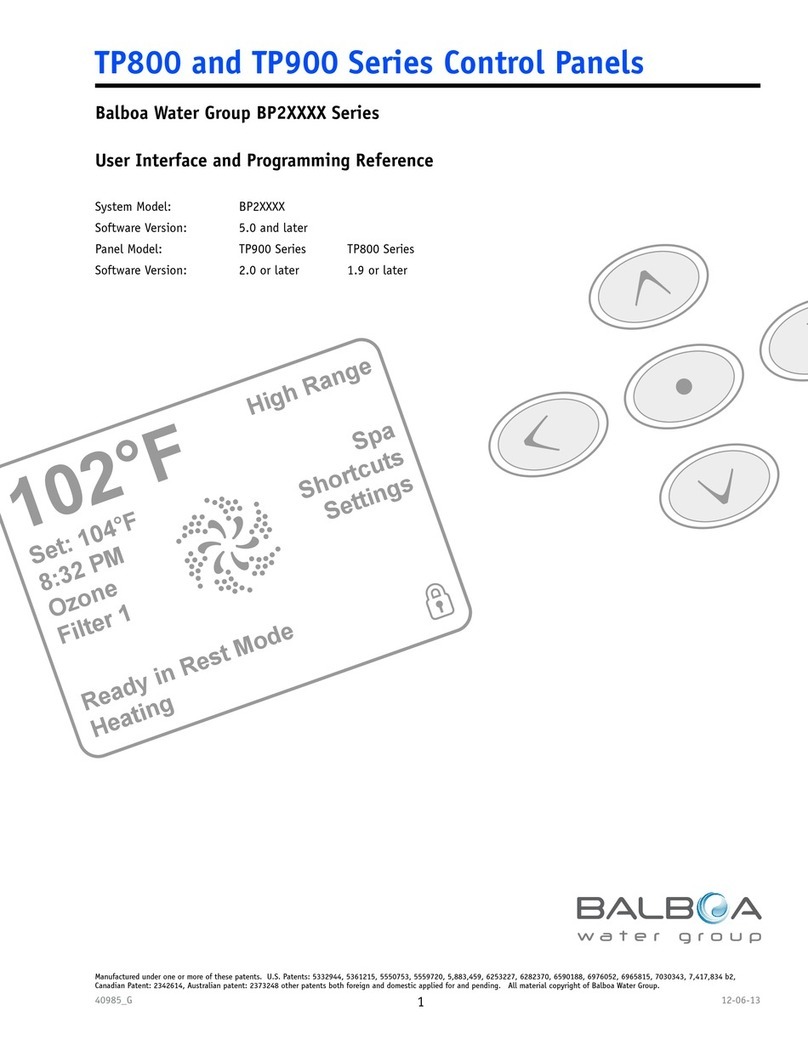
Balboa Water Group
Balboa Water Group BP2 Series User Interface and Programming Reference
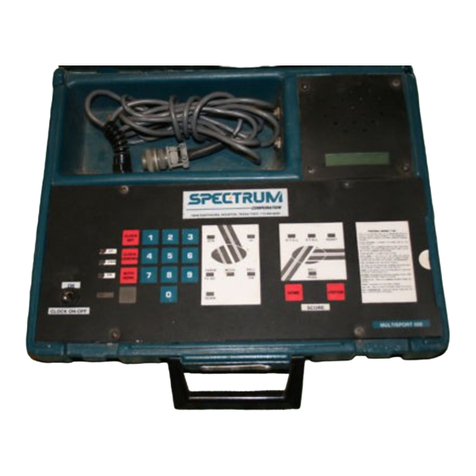
Spectrum
Spectrum MULTISPORT 500 manual
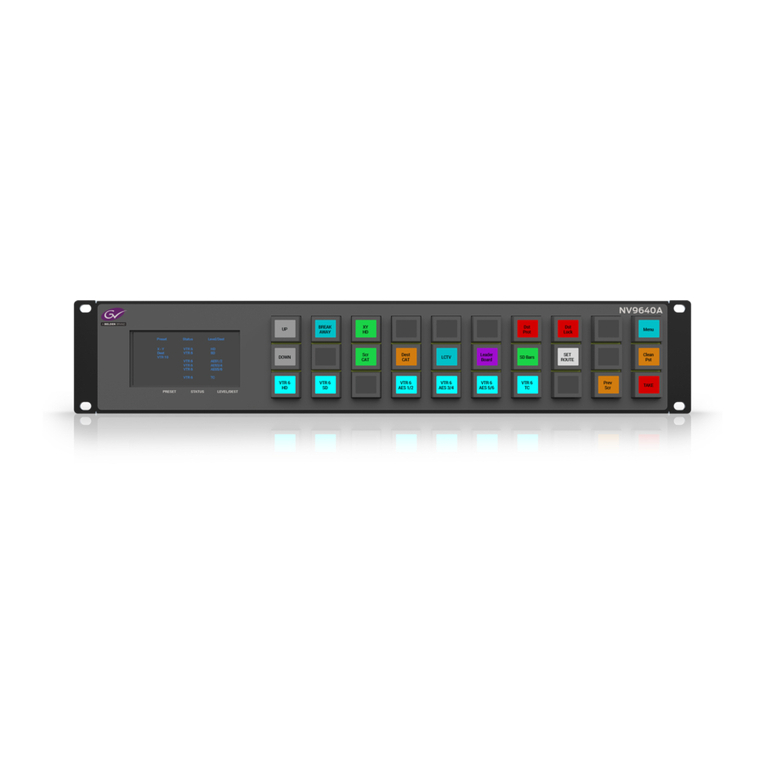
Miranda
Miranda NV9640 user guide

Menvier Security
Menvier Security TS400 operating instructions
